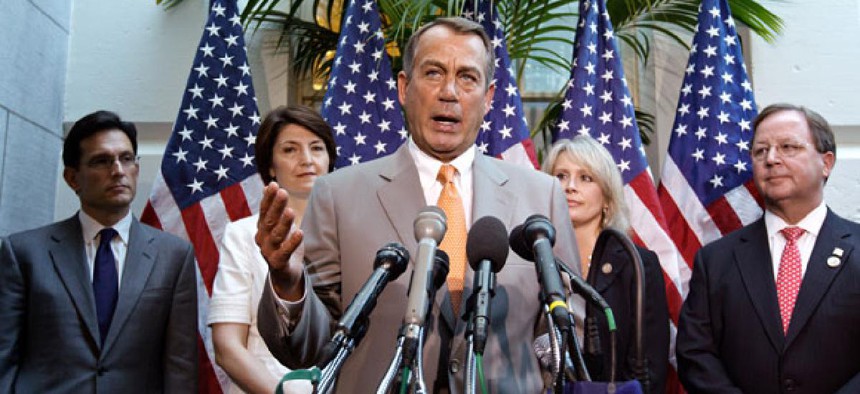The GOP Keeps Getting Whiter
While the country is becoming more racially diverse, Republican congressional districts are becoming less.
After Republicans won only 48 percent of all votes cast for the House in 2012 but 54 percent of the seats, it’s no secret that the party enjoys the huge built-in structural advantages in the chamber that Democrats had going for them decades ago. In a January memo, veteran GOP pollster Bill McInturff observed, “If you began your career as a Republican trying to win the House in the 1970s and 1980s, you would adopt, as I do, the borrowed adage, ‘There’s no crying in redistricting.’ ” The current unprecedented geographic concentration of Democratic voters was compounded by the 2010 wave election that gave Republicans unprecedented power in state legislatures to redraw political boundaries. Combined, these two demographic developments cast doubt on whether even a 2006-size wave would enable Democrats to win control of the House at any point this decade.
But could the Republicans’ arguably rigged House majority actually be a curse disguised as a blessing? It’s an interesting question. They clearly did everything they could to purge Democratic voters from their districts ahead of 2012, no matter whether those voters were white, black, Hispanic, left-handed, or right-minded—just as Democrats would have done had the roles been reversed. But in the process of quarantining Democrats, Republicans effectively purged millions of minority voters from their own districts, and that should raise a warning flag. By drawing themselves into safe, lily-white strongholds, have Republicans inadvertently boxed themselves into an alternate universe that bears little resemblance to the rest of the country?
Fresh 2010 census data by congressional district, compiled by The Cook Political Report’s House editor, David Wasserman, provides some numerical food for thought. Between 2000 and 2010, the non-Hispanic white share of the population fell from 69 percent to 64 percent, closely tracking the 5-point drop in the white share of the electorate measured by exit polls between 2004 and 2012. But after the post-census redistricting and the 2012 elections, the non-Hispanic white share of the average Republican House district jumped from 73 percent to 75 percent, and the average Democratic House district declined from 52 percent white to 51 percent white. In other words, while the country continues to grow more racially diverse, the average Republican district continues to get even whiter.
As Congress has become more polarized along party lines, it’s become more racially polarized, too. In 2000, House Republicans represented 59 percent of all white U.S. residents and 40 percent of all nonwhite residents. But today, they represent 63 percent of all whites and just 38 percent of all nonwhites. In 2012 alone, Republicans lost 11.2 million constituents to Democrats (a consequence of not only the party’s loss of a net eight House seats but also the fact GOP districts had grown faster in the previous decade and needed to shed more population during redistricting). Of the 11.2 million people Republicans no longer represent, 6.6 million, or 59 percent, are minorities.
Part of this whitening in the GOP is the result of Democrats winning some heavily minority districts from Republicans in 2012, such as California’s melting-pot 36th District, Florida’s heavily Cuban-American 26th, and Texas’s heavily Latino 23rd. Republicans in these districts fell victim to a spike in turnout among Latino Democrats. But most of this trend has to do with conscious and exclusionary choices that Republicans—in addition to a few courts and commissions—made when they drew new maps. For example, using only 2010 census data, Rep. Daniel Webster’s Central Florida district jumped from 57 percent white to 66 percent white; Rep. Pete Sessions’s Dallas-area district leaped from 42 percent to 53 percent white; and Rep. Pat Tiberi’s Central Ohio district soared from 68 percent to 88 percent white. All three Republicans had relatively close races in the last decade but won easily in 2012.
What do all these numbers boil down to? House Republicans have done a remarkable job of “sequestering” Democrats into the minority, but in the process they’ve also reduced their own incentive to reach out to groups their party badly needs if it wants to stay relevant beyond the Southern confines of the Capitol. Sure, Republicans have plenty of incentive to don those aprons at local Rotary and Kiwanis barbecues. But if half of politics is simply showing up, how many fewer GOP legislators have strong reasons to shake hands or kiss babies at Puerto Rican Day parades, Martin Luther King Jr. Day commemorations, or Asian food festivals? For many casual voters, these kinds of events might be the only opportunity to put a face to a name on a ballot; for young people, these nonpolitical events can be where partisan attachments take shape. Given the nation’s demographic trajectory, Republicans might want to take note—and show up.
David Wasserman contributed
This article appeared in the Saturday, March 16, 2013 edition of National Journal.



